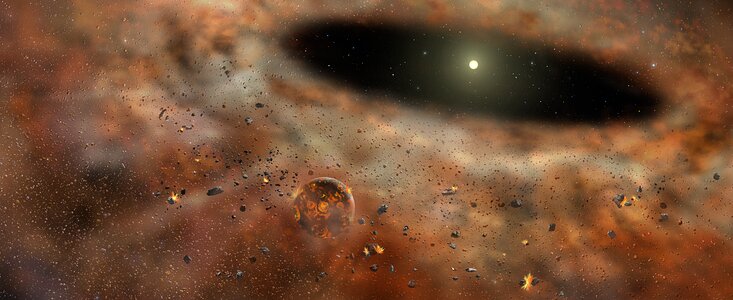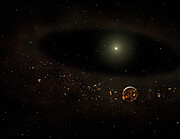Going Out Of Business
Planet-Forming Disk Turns Off Lights, Locks Doors ...
29 June 2012
That surprise you feel when your favorite store turns off its lights, locks up its doors, and suddenly, for no apparent reason, goes out of business? That's just how astronomers felt recently when a dusty disk of rocky debris around a nearby star abruptly shut down and by all appearances went out of business.
The star -- designated TYC 8241 2652 and a young analog of our Sun -- only a few years ago displayed all of the characteristics of hosting a solar system in the making. Now, it has transformed completely: very little of the warm dusty material thought to originate from collisions of rocky planets is apparent - it's a mystery that has astronomers baffled.
Carl Melis of the University of California, San Diego, led the discovery team, whose report is published in the July 5th issue of the journal Nature. He said, "It's like the classic magician's trick: now you see it, now you don't. Only in this case we're talking about enough dust to fill an inner solar system and it really is gone!"
Co-author Ben Zuckerman of the University of California Los Angeles, observed, "It's as if you took a conventional picture of the planet Saturn today and then came back two years later and found that its rings had disappeared."
The dusty disk at TYC 8241 2652 was first seen by the NASA Infrared Astronomical Satellite (IRAS) in 1983, and remained brightly glowing for 25 years. Like Earth, warm dust absorbs the energy of visible starlight (sunlight) and reradiates that heat energy as infrared radiation. An infrared image obtained at the Gemini telescope in Chile on May 1, 2012 - just as the paper was being accepted by Nature - confirmed that the warm dust has now been gone for 2.5 years.
"A perplexing thing about this discovery is that we don't have a really satisfactory explanation to address what happened around this star. The disappearing act appears to be independent of the star itself, as there is no evidence to suggest that the star zapped the dust with some sort of mega-flare or any other violent event," said Melis.
Zuckerman, who has been investigating circumstellar disks (debris disks around stars) since the 1980s, noted that "the dust disappearance at TYC 8241 2652 was so bizarre and so quick, initially I figured that our observations must simply be in error in some strange way."
Norm Murray, Director of the Canadian Institute for Theoretical Astrophysics, who was not part of the research group, said, "The history of astronomy has shown that events that are not predicted and hard to explain can be game-changers".
The lack of an existing model for what is going on around this star is forcing astronomers to rethink what happens within young solar systems in the making.
"Although we've identified a couple of mechanisms that are potentially viable, none are really compelling," said Melis. "In one case, gas produced in the impact that released the dust helps to quickly drag the dust particles into the star and thus to their doom. In another possibility, collisions of large rocks left over from an original major impact provide a fresh infusion of dust particles into the disk which then instigate a runaway process where small grains chip into oblivion both themselves and also larger grains."
Major dusty regions such as the asteroid belt and another located out beyond the orbit of Neptune are known to exist in our own solar system. Nearly 30 years ago, NASA's Infrared Astronomical Satellite (IRAS) first discovered similar regions orbiting other stars. Now hundreds of stars similar to our Sun are known to emit an excess of infrared radiation that is usually attributed to dusty materials orbiting the star in what are called debris disks. It is believed that this material results from planetary system formation and is due to collisions and reprocessing of objects like the comets and asteroids that are part of our own solar system. But nothing like the disappearing dust disk at TYC 8241 2652 had ever been seen during these three decades.
The result is based upon multiple sets of observations of TYC 8241 2652 obtained with the Thermal-Region Camera Spectrograph (T-ReCS) on the Gemini South telescope in Chile, the IRAS satellite, the Wide-field Infrared Survey Explorer (WISE) satellite, NASA's Infrared Telescope on Mauna Kea in Hawai`i, the Herschel Space Telescope of the European Space Agency, and AKARI (a Japanese/ESA infrared satellite).
TYC 8241 2652 lies in the direction of the constellation of Centaurus. Observations by Australian co-authors Simon Murphy and Michael Bessell with the Australian National University's 2.3-meter telescope established that the star is roughly 10 million years old and 450 light years distant.
Support for this work was provided by the Lawrence Livermore National Labs, the US National Science Foundation, and NASA.
Contacts
Peter Michaud
Gemini Observatory
Hilo, Hawai‘i
Tel: (808) 974-2515
Cell: 808-936-6648
Email: pmichaud@gemini.edu
Antonieta Garcia
Gemini Observatory
La Serena, Chile
Tel: 56-51-205628
Email: agarcia@gemini.edu
Carl Melis
University of California
San Diego
Tel: 858-534-6627
Email: cmelis@ucsd.edu
Ben Zuckerman
University of California
Los Angeles
Tel: 310-825-9338
Email: ben@astro.ucla.edu
About the Release
| Release No.: | gemini1206 |
| Facility: | Gemini South |
| Instruments: | T-ReCS |
| Science data: | 2012Natur.487...74M |





